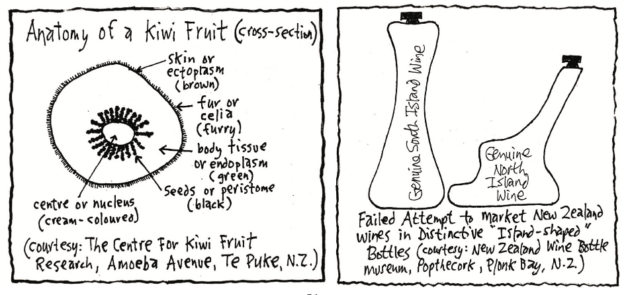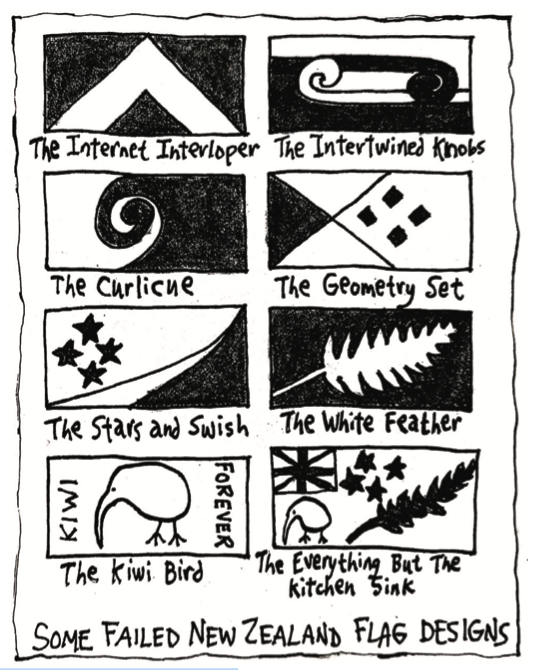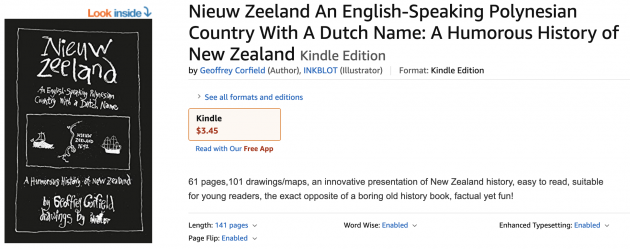You can purchase Nieuw Zeeland An English-Speaking Polynesian Country With A Dutch Name: A Humorous History of New Zealand by Geoffrey Corfield from Amazon today.
New Zealand is the first democratic country in the world to give women the vote (1893); also the first to split the atom, climb Mount Everest, fly before the Wright Brothers (perhaps, Richard Pearse, Waitohi near Temuka, Canterbury 1903), and put position numbers on rugby shirts. They also develop the jet-boat, Corriedale sheep, and kiwi fruit (originally called the “Chinese gooseberry”, New Zealand makes it bigger and sweeter and gives it a new name. Te Puke is “The Kiwi Fruit Capital of the World”)

They build towns of stone and brick (Dunedin), wood and stone (Christchurch), white limestone (Oamaru), and art deco (Napier); and lunatic asylums with pleasant-sounding names (Seacliff, Sunny- side, Cherry Farm).
They adopt the Fern Leaf badge (Boer War 1899); ANZAC Day (25 April 1915); “God Save The King/ Queen” and “God Defend New Zealand” as national anthems; and a flag (1869), which looks a lot like the Australian flag, but which New Zealand had 32 years before Australia adopted its flag (1901), which looks a lot like the New Zealand flag.
And so, despite its rather complicated history, New Zealand settles down to become one of the world’s quiet, stable, successful, organised countries (there aren’t enough of them). Things were a lot less complicated now.
It had mountains, fjords, beaches, forests, earthquakes, thermal volcanic activity, strange plants and animals that nobody else has got, cricket, rugby, wine, jet-boats, a windy capital, and a silver fern. What else did it need? What else indeed. Certainly nothing much overly complicated.
Appendix I: THE NEW ZEALAND FLAG
In 1865 the British government rules that all British colonial ships must fly a flag made up of the British Blue Ensign with the badge or emblem of the colony on it. New Zealand did not have a badge or emblem, so they put the letters “NZ” on their flag (in red with white bordering). It was a simple design and easy to sew on the Blue Ensign, but it wasn’t very distinctive or inspiring.
The idea of putting four red stars on the flag representing the Southern Cross star constellation, came from British Royal Navy officer First Lieutenant Albert Hastings Markham, who suggested it to the New Zealand governor in 1869, and had his idea quickly accepted. It is not known why he proposed the stars be red. Probably for some simple reason like it nicely matched the red in the Union Jack (probably not because he knew the Maori liked the colour red).
The 1869 flag was flown as New Zealand’s flag until it was officially adopted in 1902, just one year after Australia had officially adopted its flag, which looked suspiciously like New Zealand’s flag, but had six white stars instead of four red ones.
New Zealand though was the first country to use the Southern Cross stars on its national flag. It has four red five-pointed stars in a diamond-shaped configuration. The Southern Cross star constellation is usually shown as either four or five stars in a diamond-shaped configuration. There are four main stars and a smaller fifth star that is sometimes included (Australia’s flag includes the fifth smaller star). So it is acceptable to represent the Southern Cross with either four or five stars. However, the idea of using the Southern Cross stars on a flag goes back long before Albert Markham’s idea.
A British missionary in New Zealand designed a “United Tribes of New Zealand” flag that had a red cross with four white stars on a blue background on it (1834). The Australasian Anti-Transportation League had a blue flag with a Union Jack in the corner, five silver stars representing the Southern Cross, and a bunch of writing on it (1851). The Eureka Flag in Victoria, Australia had five white eight-pointed stars on it, but in a t-shaped not diamond-shaped configuration (1854). The Lambing Flat Riot Flag in New South Wales, Australia had five white stars on it also in a t-shaped configuration (1861). But all those stars were white, not red.
Although the Australian and New Zealand flags look very much alike (for the time being anyway), there are several ways to tell them apart. Australia is bigger than New Zealand, so it has one big star and six stars altogether, while New Zealand has four stars. The Maori of New Zealand were much more ferocious than the Aborigines of Australia, so the New Zealand stars are red and the Australian stars white. Australia had the “White Australia Policy”, so its stars are white. If all else fails, look them up in a flag book.
Now and again though the idea surfaces in New Zealand that New Zealand should have a made in New Zealand flag. The idea is proposed during World War II, and again in 1973, 1979, 1988, 1992, 1998, 2004 and 2010. But nothing happens. Until 2014. In 2014 the government decides to hold a two- part national flag referendum in 2015 and 2016. The first part will be a vote to choose a new flag. The second part will be a vote between the new flag and the current flag.
New Zealanders submit 10,292 new flag designs. A government appointed flag committee chooses a “Long List of 40”, then reduces this to a “Final 4” for the first vote (2015). But the “40” becomes “39” when one design is removed because of a copyright claim, and the “4” becomes “5” when another flag is added due to an internet petition of 50,000 signatures being received for it.

The winner of the “Final 5” vote is a flag called “The black, white and blue Silver Fern” (also known as “The White Feather”). Voter turnout is 48.78%.
The winner of the second vote is the current flag (56.6%). Voter turnout is 67.3%. So New Zealand still has the same flag. For now. Or until Australia changes its flag first. (The area that voted most for the new flag was the Auckland constituency of Tamaki (51.9%). The area that voted most for the current flag was the Maori Northland constituency of Te Tai Tokerau (81.9%).
You can purchase Nieuw Zeeland An English-Speaking Polynesian Country With A Dutch Name: A Humorous History of New Zealand from Amazon today.
Please share so others can discover The BFD.


